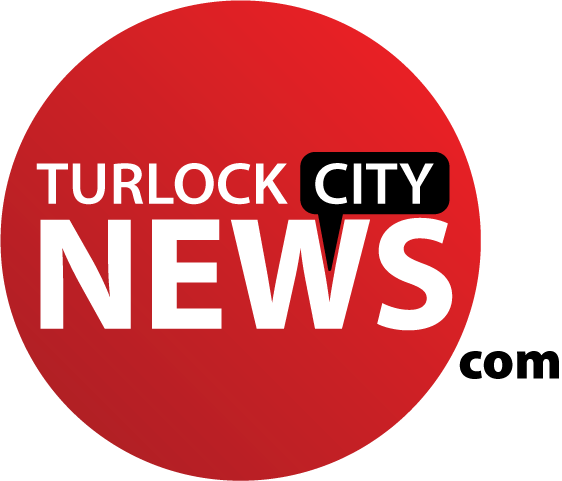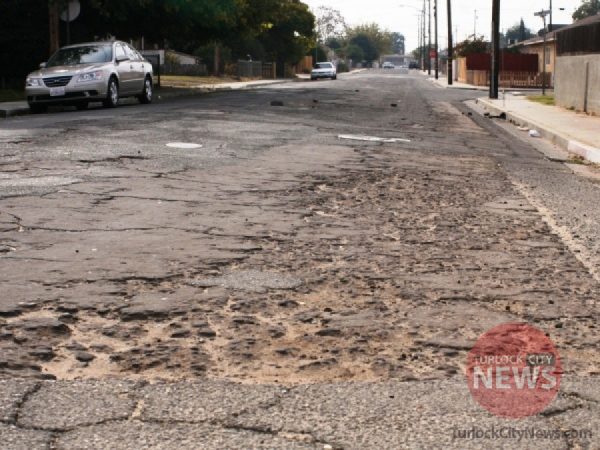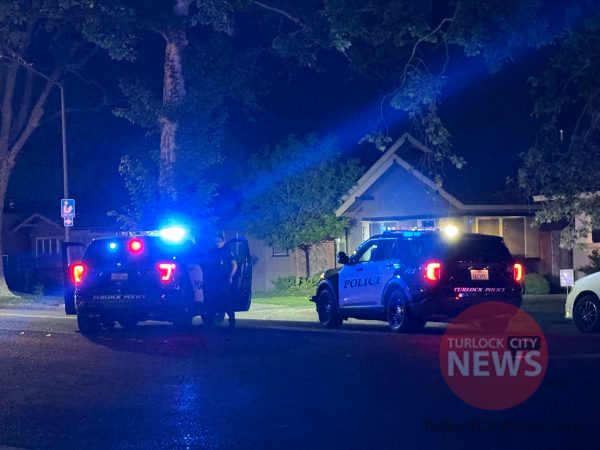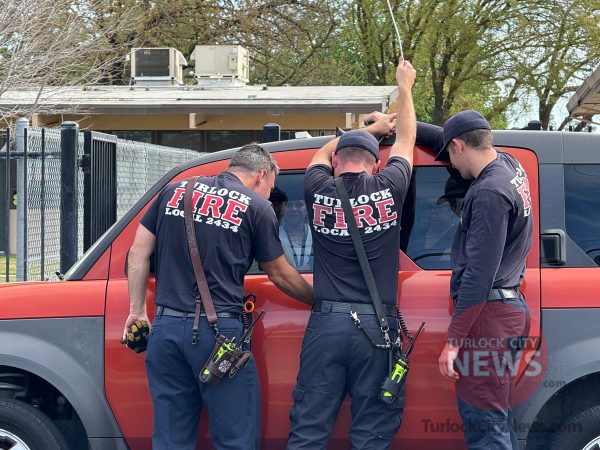The rough state of Turlock roads continues to be an important conversation amongst Turlock’s leaders and citizens, and while a solution is not on the table, collaboration and funds is necessary to finding the fix.
“I wish I could wave my magic wand and tell you how to fix it… but it’s a problem that we all have to figure out how to do together,” said Director of Development Services and City Engineer Mike Pitcock on Tuesday.
The Turlock City Council, City of Turlock staff, and residents gathered in City Hall on Tuesday to discuss the current status and look to the future on how to pay for road improvements.
Turlock roads have been deteriorating for years and now “at risk,” according to a survey completed by Nichols Consulting Engineers in 2013.
Nichols surveyed the road conditions around Stanislaus County and surveyed each road in Turlock individually using the Pavement Condition Index (PCI), a scale from 0 to 100. The results of that survey showed that Turlock roads were at a 67 PCI — which is considered “at risk.”
Failed roads score 0 to 24 PCI; poor roads score 25 to 49; at risk roads score 50 to 69; and good to excellent roads score 70 to 100.
According to the survey, 54 percent of Turlock roads were “good to excellent,” with 23 percent being “at risk,” 20 percent “poor,” and 3 percent “failed.
Compared to surrounding cities — which includes Modesto, Hughson, Ceres, Patterson, Waterford, Newman, Oakdale, and Riverbank — Turlock has the second worst roads, behind only Modesto (63 PCI); Hughson had the best roads (82 PCI).
The main cause of the decay of Turlock roads has been lack of funds dedicated to costly road repairs.
Currently, Turlock has approximately $1.25 million dedicated to road maintenance, which is combined from the Regional Surface Transportation Program, Gas Tax, and $50,000 from the General Fund.
However, according to staff, it would cost approximately $11.4 million per year over the next 20 years to bring Turlock roads back up to a “good” condition around 80 PCI.
With current funding, Turlock roads as estimated to fall to 33 PCI in 20 years, with many road around town failing.
As well as more roads failing, the cost of road repair would greatly increase as roads are neglected. According to Pitcock, the cost of a seal over a road is around $4 to $4.50 per square-foot, while a complete repaving is around $60 per square-foot.
For this reason, the City of Turlock’s plan for repaving roads would mean repaving newer roads that are in better condition before getting to the troublesome and worse roads, according to Pitcock. This was not met with much excitement from those in attendance on Tuesday, however Pitcock said it was about getting the best bang for the City’s buck.
“So it’s kind of contrary to what most people think, that you should take care of your worst roads first,” said Pitcock. “The problem is, if you take care of your worst roads first, the money doesn’t go very far."
"The idea again is get the most bang for your buck."
Pitcock also mentioned that those newer roads that are currently in assessment districts, which make up between 30 and 35 percent of the City, would not have been included in the repaving schedule under Measure B. Assessment districts are neighborhoods that pay extra fees yearly to have their roads repaved or sealed every seven years. Assessment districts are often the reason many question why the newer areas of town are being repaved so often — as assessment districts began after 1990.
However, with continued lack of funding, even assessment districts would be subject to failed roads.
While the City of Turlock is only dedicating a small amount of funds toward roads, those funds may actually decrease in coming years. Staff estimates that the Gas Tax in 2014-15 will generate $737,513, but will drop to $353,131 in 2015-16. According to Pitcock, this is because of fuel efficient vehicles using less gas, as well as the drop in gas prices.
Nonetheless, there needs to be more funds dedicated to Turlock roads, but where do they come from?
One option was the half-cent sales tax dedicated to Turlock roads, Measure B, which failed to receive the 66.7 percent approval necessary to pass in November 2014. The tax was estimated to generate approximately $5.6 million per year over the seven-year life of the tax.
While the tax may not have generated the necessary funds to improve Turlock roads, it would have at least kept the status quo.
“The status quo is the $5.6 million added to the current $1.2 [million],” said Pitcock. “If you’re wanting to improve the city system, you’re looking at something higher than that."
Roads were estimated to improve a bit in the short-term with the passage of Measure B, but would be back to around the condition in 20 years, if the City of Turlock could maintain the $6.25 million funding over the 13 years following the tax’s seven-year life.
For Mayor Gary Soiseth, the future of Turlock roads will have to come from multiple places.
“Whether we continue with the $50,000 from the general fund, do we increase that? Do we decrease that?” asked Soiseth. “So we have a lot of options."
Soiseth and Councilmember Steven Nascimento were recently appointed to an ad hoc committee to review the City of Turlock’s budget line-by-line to determine what necessary cuts or changes may need to be made.
The Mayor is also apart of the Stanislaus Council of Government, which will consider placing a countywide sales tax on the ballot in 2016. Soiseth previously said that he could not support Measure B in its November 2014 form. Soiseth will have the option to support a countywide tax, if he feels it will benefit the City of Turlock.
“I’m going to make sure I put all my weight behind it, if it’s the right thing for Turlock,” said Soiseth.
Some in attendance on Tuesday questioned whether a countywide tax would be able to pass with the 66.7 percent approval necessary and thought the possibility of another Turlock-based tax, similar to Measure B, would be more likely, after Measure B fell by only just over five percentage points. However, Stanislaus County Board Supervisor Vito Chiesa mentioned that the countywide tax in 2012 failed by only a few hundred votes.
A countywide tax will however be on a crowded ballot in 2016, according to Chiesa; the 2016 ballot will also feature a presidential race, as well as, according to Chiesa, several proposition asking for funding.
The future condition of local roads was not the only thing in question on Tuesday, many Turlock residents were also concerned with roads from a bicyclist or pedestrian perspective.
{loadposition banban6}
The City of Turlock has been working on an Active Transportation Plan for several months, which would create a plan on how local roads would accommodate bicyclists and pedestrians.
“Although poorly paved roads are terrible, poorly planned roads are just as bad, if not worse that those that have no infrastructure at all,” said Elizabeth Claes, an activist for safer bicycling in Turlock and part of Bike Turlock.
Local residents, as well as members of the City of Turlock, have been working hard on the Active Transportation Plan. According to Pitcock, the plan is to have the plan completed in April.
While the plan cannot be implemented without funding, Pitcock added that having an Active Transportation Plan will greatly boost the City of Turlock’s chances of getting grants and other funding for bicycle and pedestrian projects.
"We’ve got lots of ideas, lots of dreams, lots of thoughts and desire, just gotta have the money to do it,” said Pitcock.
Funds are the big idea, however, and the question many had was how did Turlock roads get to this point?
For many years now, very little, if any, dollars from the general fund have been dedicated to roads. Last year, Turlock City Council approved $50,000 from the general fund to be dedicated to roads, however that was the first time in years that any money from the general fund went to roads.
{loadposition banban1}
“I just think it’s something that, as times go on, I think there was a mechanism to build the roads, but I don’t know if there ever was a mechanism to maintain the roads,” said Pitcock.
The approximately $1.25 million is dedicated to roads each year, however that only pays for small projects. A larger project, such as the Monte Vista Avenue repaving, costs around $1 million or more, according to Pitcock. Larger projects are typically paid for through grants, which according to Pitcock, are a multi-year process to receive.
Other street maintenance, such as pothole filling, is not paid for through the $1.25 million for roads, it’s funded by the Parks, Recreation and Public Facilities Department budget.
Allison Van Guilder, Parks, Recreation and Public Facilities Department Manager, could not provide an exact dollar amount pulled from her department’s budget for road maintenance, but did mention the department has difficulty securing the best asphalt mix to fill Turlock potholes.
Nonetheless, the City of Turlock will continue the conversation of funding for roads in the near future as local roads continue to decay without funding.
“Somebody out there asked me, ‘How did we get here?’ And I said, ‘I don’t care, we’re here,’” said Soiseth. “So we’re going to figure out exactly where we are and move forward."







